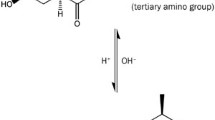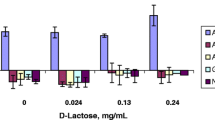Abstract
Purpose. To determine the human jejunal permeability of cimetidine and ranitidine using a regional jejunal perfusion approach, and to integrate such determinations with previous efforts to establish a baseline correlation between permeability and fraction dose absorbed in humans for soluble drugs.
Methods. A sterile multi-channel perfusion tube, Loc-I-Gut®, was inserted orally and positioned in the proximal region of the jejunum. A solution containing cimetidine or ranitidine and phenylalanine, propranolol, PEG 400, and PEG 4000 was perfused through a 10 cm jejunal segment in 6 and 8 subjects, respectively.
Results. The mean Peff (± se) of cimetidine and ranitidine averaged over both phases were 0.30 (0.045) and 0.27 (0.062) × 10−4cm/s, respectively, and the differences between the two were found to be statistically insignificant. The mean permeabilities for propranolol, phenylalanine, and PEG 400 averaged over both phases and studies were 3.88 (0.72), 3.36 (0.50), and 0.56 (0.08) × 10−4 cm/s, respectively. The differences in permeability for a given marker were not significant between phases or between the two studies.
Conclusions. The 10-fold lower permeabilities found for cimetidine and ranitidine in this study, compared to propranolol and phenylalanine, appear to be consistent with their less than complete absorption in humans.
Similar content being viewed by others
REFERENCES
T. Z. Csaky. Intestinal permeation and permeability: An overview. In T. Z. Csaky (eds.), Pharmacology of Intestinal Permeation I. Springer-Verlag, New York, 1984 pp. 51-59.
H. Lennernäs, Ö. Ahrenstedt, R. Hällgren, L. Knutson, M. Ryde and L. K. Paalzow. Regional jejunal perfusion, a new in vivo approach to study oral drug absorption in man. Pharm. Res. 9:1243-1251 (1992).
R. Modigliani, J. C. Rambaud, and J. J. Bernier. The method of intraluminal perfusion of the human small intestine. I. Principle and technique. Digestion 9:176-192 (1973).
N. Takamatsu, L. S. Welage, N. M. Idkaidek, D-Y. Liu, P. I-D. Lee, Y. Hayashi, J. K. Rhie, H. Lennernas, J. L. Barnett, V. P. Shah, L. Lesko, and G. L. Amidon. Human intestinal permeability of piroxicam, propranolol, phenylalanine and PEG 400 determined by jejunal perfusion. Pharm. Res. 14:1127-1132 (1997).
R. Larsson, P. Erlanson, G. Bodemar, B. Norlander, L. Fransson, and L. Strouth. Pharmacokinetics of cimetidine and its sulphoxide metabolite during haemodialysis. Eur. J. Clin. Pharmacol. 21:325-330 (1982).
T. Prueksaritanont, N. Sittichai, S. Prueksaritanont, and R. Vongsaroj. J. Chromatogr. 490:175-185 (1989).
D. A. Johnson and G. L. Amidon. Determination of intrinsic membrane transport parameters from perfused intestine experiments: A boundary layer approach to estimating the aqueous and unbiased membrane permeabilities. J. Theor. Biol. 131:93-106 (1988).
P. J. Sinko, G. D. Leesman, and G. L. Amidon. Predicting fraction dose absorbed in human using a macroscopic mass balance approach. Pharm. Res. 8:979-988 (1991).
H. Lennernas, I-Der Lee, U. Fagerholm, and G. L. Amidon. A residence-time distribution analysis of hydrodynamics within the intestine in man during a regional single-pass perfusion with Loc-I-Gut®: In-vivo permeability estimation. J. Pharm. Pharmacol. 49:682-686 (1997).
G. L. Amidon, J. Kou, R. L. Elliott, and E. N. Lightfoot. Analysis of models for determining intestinal wall permeabilities. J. Pharm. Sci. 69:1369-1373 (1980).
Goodman and Gilman's The Pharmacological Basis of Therapeutics, 9th Ed., McGraw-Hill, 1996 pp. 1729, 1778.
N. Piyapolrungroj, Y. S. Zhou, C. Li, G. Liu, E. Zimmermann, and D. Fleisher. Cimetidine absorption and elimination in rat small intestine. Drug Metab. Dispos. 28:65-72 (2000).
R. L. Oberle and G. L. Amidon. The influence of variable gastric emptying and intestinal transit rates on the plasma level curve of cimetidine; an explanation for the double peak phenomenon. J. Pharmacokin. Biopharm. 15:529-544 (1987).
G. L. Amidon, H. Lennernäs, V. P. Shah, and J. R. Crison. A theoretical basis for a biopharmaceutic drug classification: The correlation of in vitro drug product dissolution and in vivo bioavailability. Pharm. Res. 12:413-420 (1995).
Author information
Authors and Affiliations
Additional information
This manuscript represents the personal opinions of the author and does not necessarily represent the views or policies of the agency
This manuscript represents the personal opinions of the author and does not necessarily represent the views or policies of the agency
Rights and permissions
About this article
Cite this article
Takamatsu, N., Kim, ON., Welage, L.S. et al. Human Jejunal Permeability of Two Polar Drugs: Cimetidine and Ranitidine. Pharm Res 18, 742–744 (2001). https://doi.org/10.1023/A:1011020025338
Issue Date:
DOI: https://doi.org/10.1023/A:1011020025338




